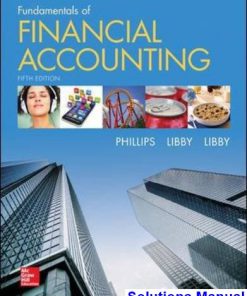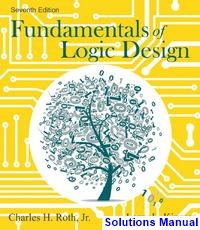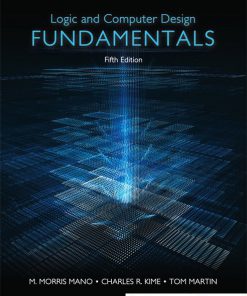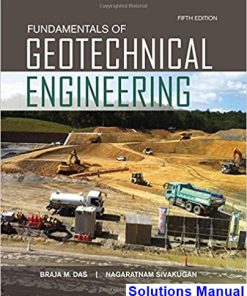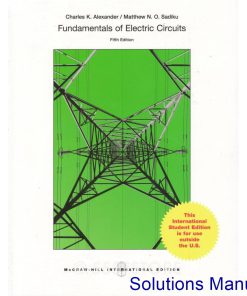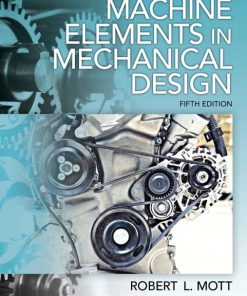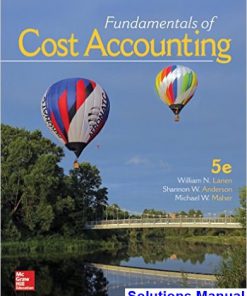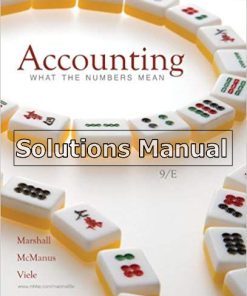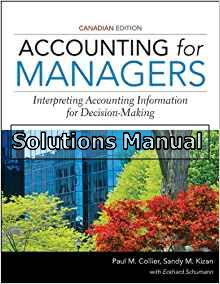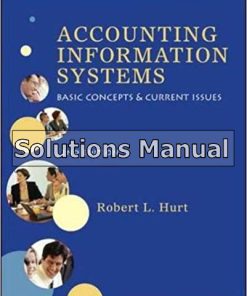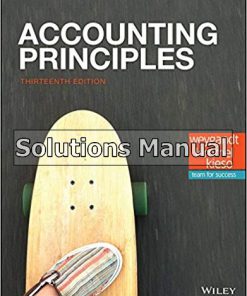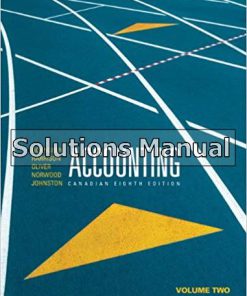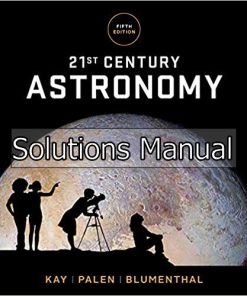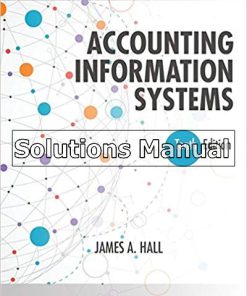Fundamentals of Machine Component Design 5th Edition Juvinall Solutions Manual
$50.00 Original price was: $50.00.$26.50Current price is: $26.50.
Fundamentals of Machine Component Design 5th Edition Juvinall Solutions Manual.
Instant download Fundamentals of Machine Component Design 5th Edition Juvinall Solutions Manual pdf docx epub after payment.
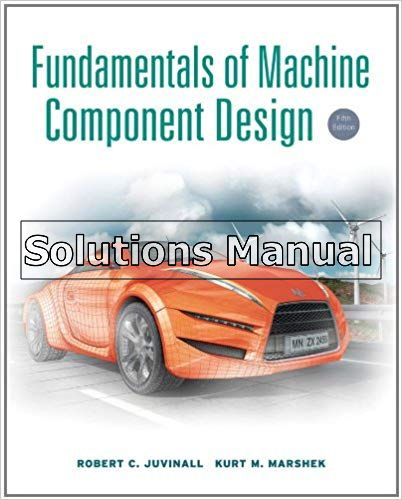
Product details:
- ISBN-10 : 1118012895
- ISBN-13 : 978-1118012895
- Author: Robert C. Juvinall (Author), Kurt M. Marshek (Author)
The latest edition of Juvinall/Marshek’s Fundamentals ofMachine Component Design focuses on sound problem solvingstrategies and skills needed to navigate through large amounts ofinformation. Revisions in the text include coverage ofFatigue in addition to a continued concentration on thefundamentals of component design. Several other new featuresinclude new learning objectives added at the beginning of allchapters; updated end-of-chapter problems, the elimination of weakproblems and addition of new problems; updated applications forcurrency and relevance and new ones where appropriate; new systemanalysis problems and examples; improved sections dealing withFatigue; expanded coverage of failure theory; and updatedreferences.
Table of contents:
Part 1 Fundamentals
Chapter 1: Mechanical Engineering design in Broad Perspective
1.1 An Overview of the Subject
1.2 Safety Considerations
1.3 Ecological Considerations
1.4 Societal Considerations,
1.5 Overall Design Considerations
1.6 Systems of Units
1.7 Methodology for Solving Machine Component Problems
1.8 Work and Energy
1.9 Power
1.10 Conservation of Energy
Chapter 2: Load Analysis
2.1 Introduction
2.2 Equilibrium Equations and Free-Body Diagrams
2.3 Beam Loading
2.4 Locating Critical Sections-Force Flow Concept
2.5 Load Division Between Redundant Supports
2.6 Force Flow Concept Applied to Redundant Ductile Structures
Chapter 3: Materials
3.1 Introduction
3.2 The Static Tensile Test-“Engineering” Stress-Strain Relationships
3.3 Implications of the “Engineering” Stress-Strain Curve
3.4 The Static Tensile Test-“True” Stress-Strain Relationships
3.5 Energy-Absorbing Capacity
3.6 Estimating Strength Properties from Penetration Hardness Tests
3.7 Use of “Handbook” Data for Material Strength Properties
3.8 Machinability
3.9 Cast Iron
3.10 Steel
3.11 Nonferrous Alloys
3.12 Plastics, and Composites
3.13 Material Selection Charts
3.14 Engineering Material Selection Process
Chapter 4: Static Body Stresses
4.1 Introduction
4.2 Axial Loading
4.3 Direct Shear Loading
4.4 Torsional Loading,
4.5 Pure Bending Loading, Straight Beams
4.6 Pure Bending Loading, Curved Beams
4.7 Transverse Shear Loading in Beams
4.8 Induced Stresses, Mohr Circle Representation
4.9 Combined Stresses-Mohr Circle Representation
4.10 Stress Equations Related to Mohr’s Circle
4.11 Three-Dimensional Stresses
4.12 Stress Concentration Factor, Kt
4.13 Importance of Stress Concentration
4.14 Residual Stresses Caused by Yielding-Axial Loading
4.15 Residual Stresses Caused by Yielding-Bending and Torsional Loading
4.16 Thermal Stresses
4.17 Importance of Residual Stresses
Chapter 5: Elastic strain, Deflection, and Stability
5.1 Introduction
5.2 Strain Definition, Measurement, and Mohr Circle Representation
5.3 Analysis of Strain-Equiangular Rosettes
5.4 Analysis of Strain-Rectangular Rosettes
5.5 Elastic Stress-Strain Relationships and Three-Dimensional Mohr Circles
5.6 Deflection and Spring Rate-Simple Cases
5.7 Beam Deflection
5.8 Determining Elastic Deflections by Castigliano’s Method
5.9 Redundant Reactions by Castigliano’s Method
5.10 Euler Column Buckling-Elastic Instability
5.11 Effective Column Length for Various End Conditions
5.12 Column Design Equations-J. B. Johnson Parabola
5.13 Eccentric Column Loading-the Secant Formula
5.14 Equivalent Column Stresses
5.15 Other Types of Buckling
5.16 Finite Element Analysis
Chapter 6: Failure Theories, Safety Factors, and Reliability
6.1 Introduction
6.2 Types of Failure
6.3 Fracture Mechanics-Basic Concepts
6.4 Fracture Mechanics-Applications
6.5 The “Theory” of Static Failure Theories
6.6 Maximum-Normal-Stress Theory, 265
6.7 Maximum-Shear-Stress Theory, 265
6.8 Maximum-Distortion-Energy Theory (Maximum- Octahedral-Shear-Stress Theory
6.9 Modified Mohr Theory
6.10 Selection and Use of Failure Theories
6.11 Safety Factors-Concept and Definition
6.12 Safety Factors-Selection of a Numerical Value
6.13 Reliability
6.14 Normal Distributions
6.15 Interference Theory of Reliability Prediction
Chapter 7: Impact
7.1 Introduction
7.2 Stress and Deflection Caused by Linear and Bending Impact
7.3 Stress and Deflection Caused by Torsional Impact
7.4 Effect of Stress Raisers on Impact Strength
Chapter 8: Fatigue
8.1 Introduction, 312
8.2 Basic Concepts, 312
8.3 Standard Fatigue Strengths ( ) for Rotating Bending, 314
8.4 Fatigue Strengths for Reversed Bending and Reversed Axial Loading, 320
8.5 Fatigue Strength for Reversed Torsional Loading, 321
8.6 Fatigue Strength for Reversed Biaxial Loading, 322
8.7 Influence of Surface and Size on Fatigue Strength, 323
8.8 Summary of Estimated Fatigue Strengths for Completely Reversed Loading, 326
8.9 Effect of Mean Stress on Fatigue Strength, 326
8.10 Effect of Stress Concentration with Completely Reversed Fatigue Loading, 334
8.11 Effect of Stress Concentration with Mean Plus Alternating Loads
8.12 Fatigue Life Prediction with Randomly Varying Loads
8.13 Effect of Surface Treatments on the Fatigue Strength of a Part
8.14 Mechanical Surface Treatments-Shot Peening and Others
8.15 Thermal and Chemical Surface-Hardening Treatments (Induction Hardening, Carburizing, and Others)
8.16 Fatigue Crack Growth
8.17 General Approach for Fatigue Design
Chapter 9: Surface Damage
9.1 Introduction
9.2 Corrosion: Fundamentals
9.3 Corrosion: Electrode and Electrolyte Heterogeneity
9.4 Design for Corrosion Control
9.5 Corrosion Plus Static Stress
9.6 Corrosion Plus Cyclic Stress
9.7 Cavitation Damage
9.8 Types of Wear
9.9 Adhesive Wear
9.10 Abrasive Wear
9.11 Fretting
9.12 Analytical Approach to Wear
9.13 Curved-Surface Contact Stresses
9.14 Surface Fatigue Failures
9.15 Closure
Part 2 Applications
Chapter 10: Threaded Fasteners and Power Screws
10.1 Introduction
10.2 Thread Forms, Terminology, and Standards
10.3 Power Screws
10.4 Static Screw Stresses
10.5 Threaded Fastener Types
10.6 Fastener Materials and Methods of Manufacture
10.7 Bolt Tightening and Initial Tension
10.8 Thread Loosening and Thread Locking
10.9 Bolt Tension with External Joint-Separating Force
10.10 Bolt (or Screw) Selection for Static Loading
10.11 Bolt (or Screw) Selection for Fatigue Loading: Fundamentals
10.12 Bolt (or Screw) Selection for Fatigue Loading: Using Special Test Data
10.13 Increasing Bolted-Joint Fatigue Strength
Chapter 11: Rivets, Welding, and Bonding
11.1 Introduction
11.2 Rivets
11.3 Welding Processes
11.4 Welded Joints Subjected to Static Axial and Direct Shear Loading
11.5 Welded Joints Subjected to Static Torsional and Bending Loading
11.6 Fatigue Considerations in Welded Joints
11.7 Brazing and Soldering
11.8 Adhesives
Chapter 12: Springs
12.1 Introduction, 497
12.2 Torsion Bar Springs, 497
12.3 Coil Spring Stress and Deflection Equations, 498
12.4 Stress and Strength Analysis for Helical Compression Springs-Static Loading
12.5 End Designs of Helical Compression Springs
12.6 Buckling Analysis of Helical Compression Springs
12.7 Design Procedure for Helical Compression Springs-Static Loading
12.8 Design of Helical Compression Springs for Fatigue Loading
12.9 Helical Extension Springs
12.10 Beam Springs (Including Leaf Springs)
12.11 Torsion Springs
12.12 Miscellaneous Springs
Chapter 13: Lubrication and Sliding Bearings
13.1 Types of Lubricants
13.2 Types of Sliding Bearings
13.3 Types of Lubrication
13.4 Basic Concepts of Hydrodynamic Lubrication
13.5 Viscosity
13.6 Temperature and Pressure Effects on Viscosity
13.7 Petroff’s Equation for Bearing Friction
13.8 Hydrodynamic Lubrication Theory
13.9 Design Charts for Hydrodynamic Bearings
13.10 Lubricant Supply
13.11 Heat Dissipation, and Equilibrium Oil Film Temperature
13.12 Bearing Materials
13.13 Hydrodynamic Bearing Design
13.14 Boundary and Mixed-Film Lubrication
13.15 Thrust Bearings
13.16 Elastohydrodynamic Lubrication
Chapter 14: Rolling-Element Bearings
14.1 Comparison of Alternative Means for Supporting Rotating Shafts
14.2 History of Rolling-Element Bearings
14.3 Rolling-Element Bearing Types
14.4 Design of Rolling-Element Bearings
14.5 Fitting of Rolling-Element Bearings
14.6 “Catalogue Information” for Rolling-Element Bearings
14.7 Bearing Selection
14.8 Mounting Bearings to Provide Properly for Thrust Load
Chapter 15: Spur Gears
15.1 Introduction and History
15.2 Geometry and Nomenclature
15.3 Interference and Contact Ratio
15.4 Gear Force Analysis
15.5 Gear-Tooth Strength
15.6 Basic Analysis of Gear-Tooth-Bending Stress (Lewis Equation)
15.7 Refined Analysis of Gear-Tooth-Bending Strength: Basic Concepts
15.8 Refined Analysis of Gear-Tooth-Bending Strength: Recommended Procedure
15.9 Gear-Tooth Surface Durability-Basic Concepts
15.10 Gear-Tooth Surface Fatigue Analysis-Recommended Procedure
15.11 Spur Gear Design Procedures
15.12 Gear Materials
15.13 Gear Trains
Chapter 16: Helical, Bevel, and Worm Gears
16.1 Introduction
16.2 Helical-Gear Geometry and Nomenclature
16.3 Helical-Gear Force Analysis
16.4 Helical-Gear-Tooth-Bending and Surface Fatigue Strengths
16.5 Crossed Helical Gears
16.6 Bevel Gear Geometry and Nomenclature
16.7 Bevel Gear Force Analysis
16.8 Bevel-Gear-Tooth-Bending and Surface Fatigue Strengths
16.9 Bevel Gear Trains; Differential Gears
16.10 Worm Gear Geometry and Nomenclature
16.11 Worm Gear Force and Efficiency Analysis
16.12 Worm-Gear-Bending and Surface Fatigue Strengths
16.13 Worm Gear Thermal Capacity
Chapter 17: Shafts and Associated Parts
17.1 Introduction
17.2 Provision for Shaft Bearings
17.3 Mounting Parts onto Rotating Shafts
17.4 Rotating-Shaft Dynamics
17.5 Overall Shaft Design
17.6 Keys, Pins, and Splines
17.7 Couplings and Universal Joints
Chapter 18: Clutches and Brakes
18.1 Introduction
18.2 Disk Clutches
18.3 Disk Brakes
18.4 Energy Absorption and Cooling
18.5 Cone Clutches and Brakes
18.6 Short-Shoe Drum Brakes
18.7 Eternal Long-Shoe Drum Brakes
18.8 Internal Long-Shoe Drum Brakes
18.9 Band Brakes
Chapter 19: Miscellaneous Machine Components
19.1 Introduction
19.2 Flat Belts
19.3 V-Belts
19.4 Toothed Belts
19.5 Roller Chains
19.6 Inverted-Tooth Chains
19.7 History of Hydrodynamic Drives
19.8 Fluid Couplings
19.9 Hydrodynamic Torque Converters
Chapter 20: Machine Component Interrelationships (ONLINE ONLY)
Appendix A: Units
A-1a Conversion Factors for British Gravitational, English, and SI Units
A-1b Conversion Factor Equalities Listed by Physical Quantity
A-2a Standard SI Prefixes
A-2b SI Units and Symbols
A-3 Suggested SI Prefixes for Stress Calculations
A-4 Suggested SI Prefixes for Linear-Deflection Calculations
A-5 Suggested SI Prefixes for Angular-Deflection Calculations
Appendix B: Properties of Sections and Solids
B-1a Properties of Sections, 813
B-1b Dimensions and Properties of Steel Pipe and Tubing Sections, 814
B-2 Mass and Mass Moments of Inertia of Homogeneous Solids, 816
Appendix C: Material Properties and Uses
C-1 Physical Properties of Common Metals
C-2 Tensile Properties of Some Metals
C-3a Typical Mechanical Properties and Uses of Gray Cast Iron
C-3b Mechanical Properties and Typical Uses of Malleable Cast Iron
C-3c Average Mechanical Properties and Typical Uses of Ductile (Nodular) Iron
C-4a Mechanical Properties of Selected Carbon and Alloy Steels
C-4b Typical Uses of Plain Carbon Steels
C-5a Properties of Some Water-Quenched and Tempered Steels
C-5b Properties of Some Oil-Quenched and Tempered Carbon Steels
C-5c Properties of Some Oil-Quenched and Tempered Alloy Steels
C-6 Effect of Mass on Strength Properties of Steel
C-7 Mechanical Properties of Some Carburizing Steels
C-8 Mechanical Properties of Some Wrought Stainless Steels
C-9 Mechanical Properties of Some Iron-Based Superalloys
C-10 Mechanical Properties, Characteristics, and Typical Uses of Some Wrought Aluminum Alloys
C-11 Tensile Properties, Characteristics, and Typical Uses of Some Cast-Aluminum Alloys
C-12 Temper Designations for Aluminum and Magnesium Alloys
C-13 Mechanical Properties of Some Copper Alloys
C-14 Mechanical Properties of Some Magnesium Alloys
C-15 Mechanical Properties of Some Nickel Alloys
C-16 Mechanical Properties of Some Wrought-Titanium Alloys
C-17 Mechanical Properties of Some Zinc Casting Alloys
C-18a Representative Mechanical Properties of Some Common Plastics
C-18b Properties of Some Common Glass-Reinforced and Unreinforced Thermoplastic Resins
C-18c Typical Applications of Common Plastics
C-19 Material Classes and Selected Members of Each Class
C-20 Designer’s Subset of Engineering Materials
C-21 Processing Methods Used Most Frequently with Different Materials
C-22 Joinability of Materials
C-23 Materials for Machine Components
C-24 Relations Between Failure Modes and Material Properties
Appendix D: Shear, Moment, and Deflection Equations for Beams
D-1 Cantilever Beams
D-2 Simply Supported Beams
D-3 Beams with Fixed Ends
Appendix E: Fits and Tolerances
E-1 Fits and Tolerances for Holes and Shafts
E-2 Standard Tolerance for Holes and Shafts
E-1 Tolerance Grades Produced from Machining Processes
Appendix F: MIL-HDBK-5J, Department of Defense Handbook: Metallic Materials and Elements For Aerospace Vehicle Structures
Appendix G: Force Equilibrium: A Vectorial Approach
Appendix H: Normal Distributions
Appendix I: SN-Formula Appendix J: Gear Terminology and Contact-Ratio Analysis
People also search:
undamentals of Machine Component Design 5th Edition
undamentals of Machine Component Design 5th Edition pdf
undamentals of Machine Component Design
what are the components of a machine
components of a machine learning model
what are the main components of an nc machine
Instant download after Payment is complete
You may also like…
Information Technology
Fundamentals of Logic Design 7th Edition Roth Solutions Manual
Information Technology
Logic and Computer Design Fundamentals 5th Edition Mano Solutions Manual
Related products
Solutions Manual
Solutions Manual
Accounting Information Systems 2nd Edition Hurt Solutions Manual
Solutions Manual
Accounting Principles 13th Edition Weygandt Solutions Manual
Solutions Manual
Accounting Volume 2 Canadian 8th Edition Horngren Solutions Manual
Solutions Manual
Solutions Manual
Accounting Information Systems 10th Edition Hall Solutions Manual




